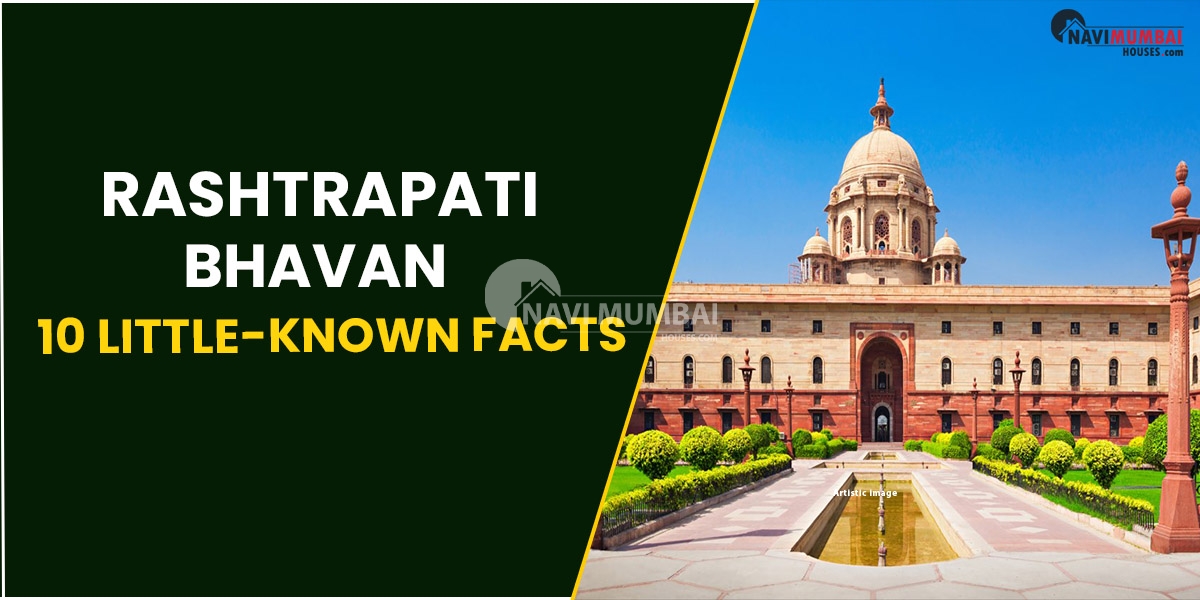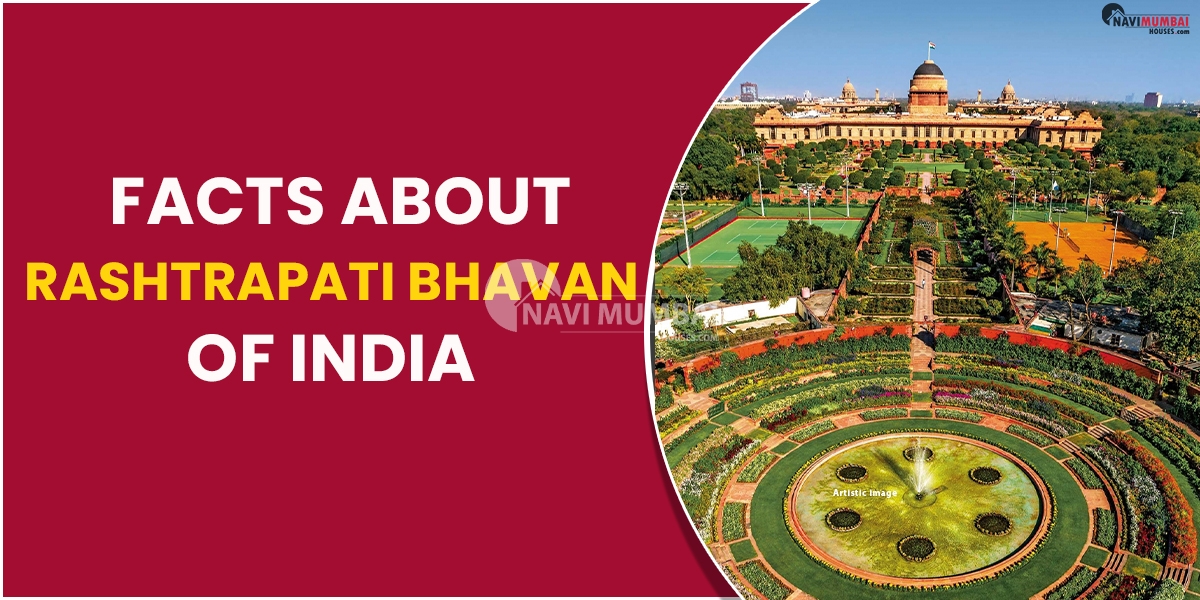
Rashtrapati Bhavan : 10 Little-Known Facts About India’s President’s Residence
Rashtrapati Bhavan, located at the western end of the Rajpath in New Delhi, is a magnificent structure that serves as the official residence of the President of India. India’s most recognisable monuments, having witnessed several historic events that shaped Indian history.
Rashtrapati Bhavan is a magnificent mansion in and of itself, and the sprawling lush green lawns surrounding it are a popular tourist attraction in Delhi.
This blog will take you on a virtual tour of the world’s largest democracy’s home. We will provide you with all of the information you require about the Rashtrapati Bhavan, also known as the President House of India. including its fascinating history, magnificent architecture, and other fascinating facts
Are you looking flat for sale panvel?
The President of India, Draupadi Murmu
Draupadi Murmu’s Biography – On July 25, 2022, Draupadi Murmu took the oath of office as the 15th President of India. Murmu, 64, is a tribal leader from Rairangpur, Odisha, and the first person from India’s Schedule Tribe community to be elected President.
Prior to her presidency, Draupadi Murmu served as the 9th Governor of Jharkhand from 2015 to 2021, and she also held various political positions in the Government of Odisha’s cabinet from 2000 to 2004. Prior to entering politics, she worked as a teacher in Rairangpur until 1997, and then as a clerk in the State Irrigation and Power Department from 1979 to 1983.
Draupadi Murmu received the Nilkantha award for best MLA from the Odisha Legislative Assembly in 2007. And, as a result of her tireless efforts, Draupadi Murmu has added another feather to her cap by becoming the President of India.
Some Unknown Facts About Rashtrapati Bhavan
President House is the world’s second largest state residence.
Rashtrapati Bhavan, also known as the President’s Estate, is the official residence of India’s President. The Governor-residence, General’s now known as Rashtrapati Bhavan, was given a prominent position in the New Delhi architecture plan. The President’s House of India has nearly 300 rooms, including the Rashtrapati Bhavan’s staff rooms. This massive structure was created using sketches sent by Lutyens to architect Herbert Baker in 1912. The design was inspire by Indian architecture by British architect Edwin Landseer Lutyen. Rashtrapati Bhavan is said to be the world’s second-largest residence of a head of state, owing to its size and number of rooms.
How Long Did Construction Take? approximately 17 years
This iconic building, which is nothing short of a marvel of architecture, took over 29,000 workers and nearly 17 years to complete. The Rashtrapati Bhavan, or President House of India, was built with 700 billion bricks.
The Maze of Rooms Inside India’s President House
Can you guess how many rooms the Rashtrapati Bhawan has? It has 340 rooms, which is more than most five-star hotels. In addition, the Rashtrapati Bhavan has 74 verandas and 18 stairways. In addition, there are several auditoriums, a large banquet hall, a prominent Durbar hall, clock towers, and the Ashok hall. The complex is further complemented by 37 fountains. So you can imagine the massive interiors of the place. You’d definitely need a tour guide to get around here!
Rashtrapati Bhavan Udhyanotsav in Mughal Gardens
Every year, the President House of India, or the Rashtrapati Bhavan, organises an event called Udhyanotsav. The event features over 100 flower varieties in Rashtrapati Bhavan’s Mughal Gardens.
Visitors are welcome to visit this area of Rashtrapati Bhavan and walk through the Mughal Gardens, which cover an area of 15 acres. This heavenly garden contains a wide variety of roses, daffodils, Asiatic lilies, hyacinths, and seasonal flowers.
Rashtrapati Bhavan’s Guest Wing
The Guest Wing of the Rashtrapati Bhavan is also known as the South West Wing. It has three stories. The first floor is reserved for all Heads of State and senior members of the delegation. There are also two prominent suites, Dwarka and Nalanda, which are used for the stay of Heads of State, their delegations, and other important dignitaries.
Originally, the Viceroys and their families lived in this wing. However, after being appointed as the first Indian Governor-General, C. Rajagopalachari decided to relocate to the northwestern part of the Rashtrapati Bhavan because the Viceroy’s Suite was too fancy for him. Since then, the North West Wing has served as Rashtrapati Bhavan’s residential wing. The Dwarka Suite is the largest of the Rashtrapati Bhavan’s Guest Wing suites, followed by the Nalanda Suite. These suites have a beautiful view of the Mughal Garden.
Rashtrapati Bhavan’s ‘Gift Hall’
Rashtrapati Bhavan has a dedicated hall that displays all of the gifts that the President of India has received. It also contains two silver chairs used by King George V.
Rashtrapati Bhavan’s Children’s Gallery
The President’s House has two galleries for children. The first gallery is titled ‘By the Children,’ and it displays paintings and sketches presented to the President. The second gallery is titled ‘For the Children.’ This gallery contains items of interest to children, such as musical instruments, time zones, a model newspaper, optical illusion devices, and so on.
Durbar Hall’s Centennial Buddha Statue
We’re guessing that most of you were unaware that there is a Buddha statue in Rashtrapati Bhavan’s Durbar Hall. Yes, inside Rashtrapati Bhavan is a magnificent and massive statue of Gautam Buddha from the Gupta period. The antique statue dates from the fourth century and is a classic work from the golden age of art.
The Civil and Defence Investiture ceremonies are held in the Durbar Hall, which houses the Buddha statue; the Durbar Hall in the Presidential Estate is one of the major attractions. It is one of the most important areas of the President House of India because it is used to organise the newly form government’s Swearing-in ceremony, the Council of Ministers, and the Chief Justice of India’s Swearing-in ceremony. This hall inside the President’s residence can be accesse from three sides: the front forecourt and the grey marble stairs on both sides of Durbar Hall.
Statues in Rashtrapati Bhavan’s Marble Hall
The Marble Hall transports you back to the time of the Viceroy and the Royal British family. The museum section of Rashtrapati Bhawan displays wax statues and portraits of the Viceroy and the British Royal family. It also displays sculptures and mementos from the British Viceroys of India prior to India’s independence.
Kitchen Museum In President House of India
The Kitchen Museum Inside the President House of India, Rashtrapati Bhavan, is a Kitchen Museum. Doesn’t that sound intriguing? This fascinating section of the Rashtrapati Bhavan Museum houses a collection of utensils and dishes used in the President of India’s kitchen in the past. It also exhibits kitchenware used since 1911, when India’s capital moved from Kolkata to Delhi.
Rashtrapati Bhavan’s Ashoka Hall
The President’s House of India’s Ashoka Hall is yet another beautifully decorate room. The Ashoka Hall, which was previously use as the State Ballroom, is now use to organise various ceremonial functions. The ceiling, which has a mesmerising oil painting design, is the highlight of this area of Rashtrapati Bhavan.
The Persian-style carpet, specially designed to match the grandeur of Rashtrapati Bhavan’s Ashoka Hall, is another element that will take your breath away.
Ashoka Hall is tastefully decorate with stunning art pieces, including a long case clock. This exceptional piece was made in England and bears the markings British Clock Enfield by Cooke & Kelvey Ltd, Calcutta.
What Visitors Can See Inside Rashtrapati Bhavan
The Rashtrapati Bhavan Museum is a must-see attraction. Rashtrapati Bhavan houses the President’s antique buggy and an old Mercedes given to the late former President Rajiv Gandhi by Jordan’s King.
The Rashtrapati Bhavan museum also displays the President’s gift collection from various foreign delegates.
You must take an extensive inside tour of the Rashtrapati Bhavan gardens, including the Herbal Garden, Spiritual Garden, Musical Garden, Biofuel Park, terrace gardens on the north and south ends, and so on.
Last but not least, go inside the Rashtrapati Bhavan to see the magnificent Durbar Hall, North Drawing Room, Ashoka Hall, Nalanda Suite, and Marble Hall. Beautiful chandeliers adorn the halls, which are elegantly decorated. The Durbar Hall witnesse the historic moment when the first government of Independent India was sworn in.
Timings for Visitor Tours
Rashtrapati Bhavan is accessible to visitors via three different tour circuits:
- Circuit 1: consists of a tour of the Rashtrapati Bhavan and its central lawn.
- 2: consists of the museum.
- 3: includes the Mughal Gardens as well as a few other gardens.
The fee is Rs 50 per person, per circuit. The hours are 9 a.m. to 4 p.m.
You can reserve a tour at https://rb.nic.in/rbvisit/visit plan.aspx.
History of Rashtrapati Bhavan
This magnificent structure known as Rashtrapati Bhavan, formerly known as Viceroy’s House, was constructed during the British era. When Delhi was declare the new capital of British India after Kolkata in 1911, the Britishers built several buildings in Delhi, the most notable example of which is Rashtrapati Bhavan, or the President’s house.
When Delhi was chosen as the capital, the British decided to build a residence for the British Viceroy, which was given to two prominent architects, Sir Edwin Lutyens and Herbert Baker. Rashtrapati Bhavan construction began in 1912, took approximately 17 years to complete, and was complete in 1929.
This massive and awe-inspiring structure required the work of approximately 29,000 artisans. Around 4,000 hectares of land were acquire from the Malcha and Raisina villages for the construction of Rashtrapati Bhavan. This structure costs nearly a crore, or 40 lakh rupees in the British era.
The Magnificent Architecture of Rashtrapati Bhavan
The President’s official residence is the ‘President House of India,’ or ‘Rashtrapati Bhavan,’ as it is colloquially known. This building’s neo-classical architecture is a magnificent blend of Mughal, Indian, and Western architecture. It is a four-story mansion spread across approximately 330 acres.
Rashtrapati Bhavan has 340 rooms, 74 verandas, 18 stairways, 37 fountains, several auditoriums, a massive banquet hall, prominent Durbar hall, Clock Tower, Ashok hall, gardens, and so on.
Rashtrapati Bhavan’s iconic structure was design with several Indian and scientific elements in mind. The President House of India was inspired by the Indian archaeological system and features Chakras, jaalis, and balconies.
Inside, Rashtrapati Bhavan has 12 massive pillars with elegantly carved bells. The bells found in Hindu and Jain temples inspired this design. These pillars in Karnataka’s Rashtrapati Bhavan were inspire by the Mudabari Jain Temple.
After the country’s constitution went into effect in 1950, this building, which was once the Viceroy’s residence, became the President of India’s official address.
In Conclusion – Inside Rashtrapati Bhavan
The lesser-known facts about the President’s residence, Rashtrapati Bhavan, and the lavish architecture are enough to impress anyone. Simply put, Rashtrapati Bhavan – the Indian President’s residence – is an architectural marvel that represents a unique mix of a government power centre and stronghold that speaks volumes about India’s rich heritage.
Affordable 2 BHK Flat For Rent In Kharghar Sector 20
You’re looking for Buy Home In Navi Mumbai we have the Best Buy Properties In Navi Mumbai Like Ready to Move & Nearby possession: https://navimumbaihouses.com/property/search/buy/navi-mumbai-all/
If you want daily property update details please follow us on Facebook Page / YouTube Channel / Twitter










